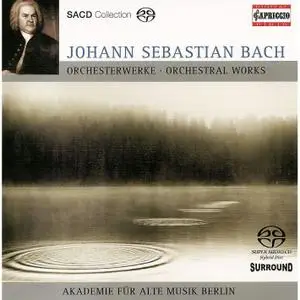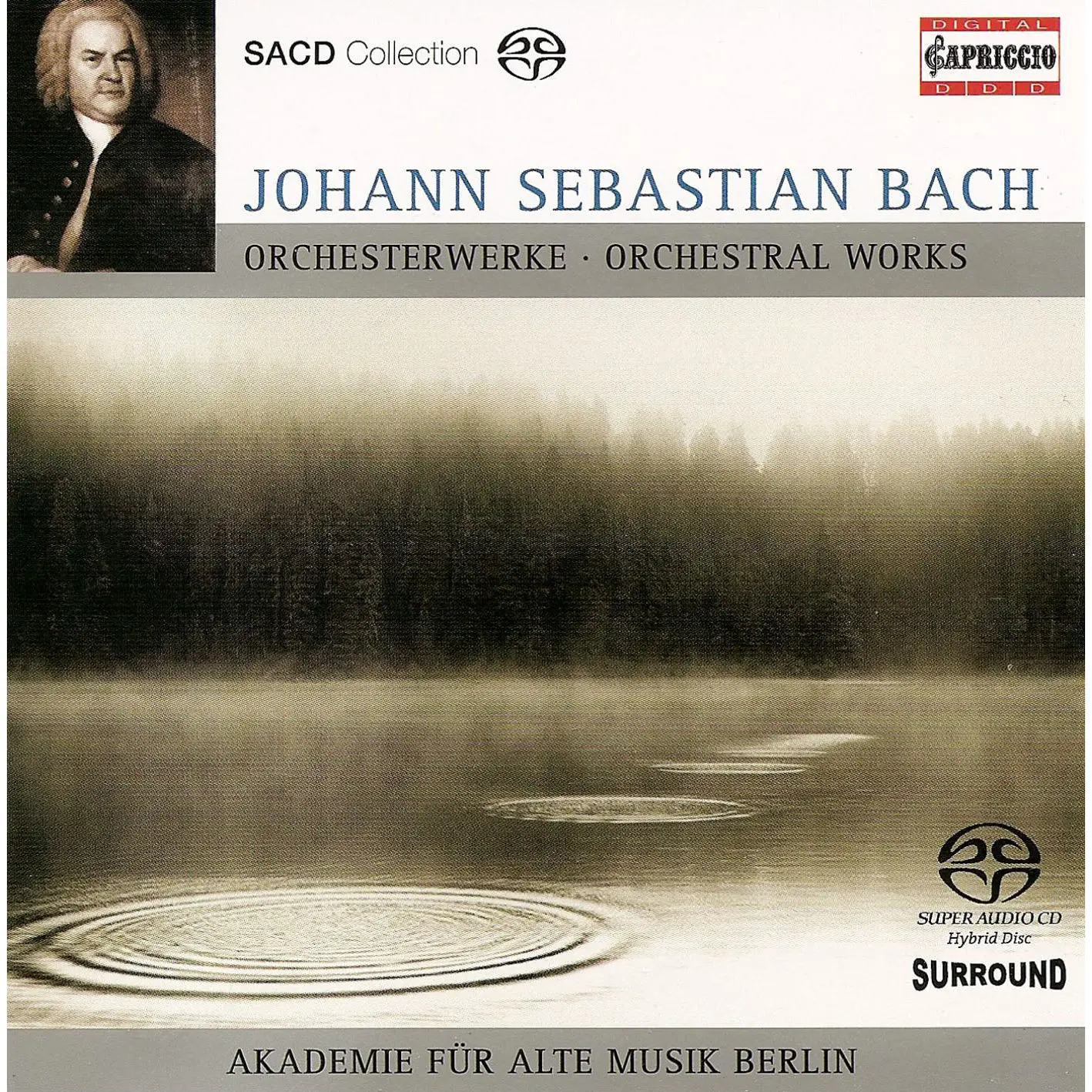Akademie für Alte Musik Berlin - J.S. Bach: Brandenburg Concerto No. 5, Concerto for 2 Keyboards, Bwv 1061, Overture (Suite) No. 2 (2005)
WEB | FLAC (tracks) - 338 MB | 56:59
Genre: Classical | Label: Capriccio
WEB | FLAC (tracks) - 338 MB | 56:59
Genre: Classical | Label: Capriccio
Many fine recordings over the years have taught me that they know Bach in Leipzig, so I expected a lot from this recording, and wasn’t disappointed. These are possibly the best, or at least equal to the best, performances of these frequently performed works I’ve ever heard.
They are very fast, but there is no sense of the music being rushed; it simply erupts at this tempo as if it couldn’t help itself, as if this were the only way it could possibly be played. Having just finished reading and reviewing a book on the origins of our ideas of original performance practice, this recording is a perfect example of what it was all about, Bach’s music pretty much the way he played it and heard it himself. This music could not have been played this way fifty years ago, even thirty years ago, because it was necessary not only to know, but to get used to knowing, how to play like this. And, these are chamber music performances, not "orchestra" versus "soloist" performances, again, close to the way we presume it was played in Bach’s time.
The "Brandenburg" Concerto No. 5 is generally credited with being the first solo keyboard concerto ever written, and it was at one time played on the piano by famous pianists before famous orchestras. These large forces required slower tempi, and those slower tempi tended to stick in the first recordings for smaller forces. Then, with the first explorations of original performance practice, musicians tried playing faster, uncomfortably so, because they felt they ought to. But this performance, the fastest I’ve ever heard, is also the most natural sounding. This is more an accompanied trio, like the Beethoven Op. 56 than a keyboard concerto. It would be interesting to hear a performance where the violin and flute acted like co-soloists and improvised their own cadenzas at appropriate places; this would be the final step in ultimately authenticating this music.
The Concerto in C may have been originally written as a duet for harpsichords, and the orchestral accompaniment may have been an afterthought.
The Second Orchestral Suite has been frequently performed as a solo concerto by flutists such as Galway, Petri and Rampal, and has been recorded by Simion Stanciu on the panpipes and Maurice André on the trumpet; it always works, of course. But like the other works on this disk it is chamber music and while the flute carries the bulk of the musical responsibility, everybody should be heard and the interactions evident. These "Suites" of Bach are actually "overtures" in the direct line of ancestry of the late Haydn symphonies which set the form for almost all modern symphonies. Indeed Mahler "modernised" the orchestration and programmed them as Bach’s "Symphonies" in Vienna; but this of all the suites is the least suitable for that treatment, and the style of this recording comes closest to the authentic nature of the work.
The surround sound perspective is front-centred with ambient information from the rear channels. It is a shame the orchestra seating wasn’t expanded so the extra channels could give us greater separation of the voices. Some would denounce that as a "gimmick", but the truth is chamber music is written to be played by musicians sitting in a group, close to each other. Our modern concert hall perspective, sitting 50 metres away in the middle of a crowd of 1000 or more people, a perspective all but unknown before the nineteenth century, is not the natural way to listen to chamber music or any eighteenth century music. Each player hears the other players from all around him. It is the audience-versus-stage perspective in chamber music that is false, that is the "gimmick." A surround sound recording of a string quartet should invariably have one instrument in each corner of the listening room, or at the very least, offer a sound stage of 120 degrees or more. That would be the most authentic recording perspective, the one that most closely expresses the composer’s intentions.
An obvious point here relates to the two harpsichords in the concerto. They are placed very close to each other, just to the right of centre, with harpsichord II just behind harpsichord I. The writing is a duet for soloists; they comment on each other’s lines now and then in question-and-answer style. Perhaps placing the instruments close together makes it easier for the players to hear each other and stay together, but we, the audience, are missing out on much of the fun of the interplay between them. It would be easy to seat the harpsichordists close to each other but have the sounding boards pointing out, and then accentuate this with microphone placement. The ideal is what we have from AIX records, a surround sound "stage mix" with the instruments in a circle around the listener; that way the listener can participate in the music as the composer intended. – Paul Shoemaker
Track List:
Brandenburg Concerto No. 5 in D major, BWV 1050 (Johann Sebastian Bach)
1. I. Allegro 08:55
2. II. Affettuoso 04:58
3. III. Allegro 05:00
Concerto for 2 Keyboards in C major, BWV 1061 (Johann Sebastian Bach)
4. I. [Allegro] 06:28
5. II. Adagio 03:39
6.. III. Vivace 04:53
Overture (Suite) No. 2 in B minor, BWV 1067 (Johann Sebastian Bach)
7. Orchestral Suite No. 2 in B Minor, BWV 1067: I. Ouverture 10:10
8. Orchestral Suite No. 2 in B Minor, BWV 1067: II. Rondeau 01:43
9. Orchestral Suite No. 2 in B Minor, BWV 1067: III. Sarabande 02:55
10. Orchestral Suite No. 2 in B Minor, BWV 1067: IV. Bourree I-II 02:05
11. Orchestral Suite No. 2 in B Minor, BWV 1067: V. Polonaise - Double 03:33
12. Orchestral Suite No. 2 in B Minor, BWV 1067: VI. Menuet 01:00
13. Orchestral Suite No. 2 in B Minor, BWV 1067: VII. Badinerie 01:40
Performers:
Akademie Für Alte Musik Berlin
–––––––––––-
DON'T MODIFY THIS FILE
–––––––––––-
PERFORMER: auCDtect Task Manager, ver. 1.6.0 RC1 build 1.6.0.1
Copyright © 2008-2010 y-soft. All rights reserved
http://y-soft.org
ANALYZER: auCDtect: CD records authenticity detector, version 0.8.2
Copyright © 2004 Oleg Berngardt. All rights reserved.
Copyright © 2004 Alexander Djourik. All rights reserved.
FILE: 01 - I. Allegro.flac
Size: 53519731 Hash: 50538A2E5A12D64F16C2CB2C664D7003 Accuracy: -m0
Conclusion: CDDA 99%
Signature: 70EF93FB0DF43619033405B1A5F4C20C421F822B
FILE: 02 - II. Affettuoso.flac
Size: 24967889 Hash: 58D69E616E125533BDC8E61D3B5A1D72 Accuracy: -m0
Conclusion: CDDA 100%
Signature: 430C140A2C0D3F79094F1C4F351D99A760FFF34F
FILE: 03 - III. Allegro.flac
Size: 28391708 Hash: C2331FE8F1A4AB2F74A43E6104CC3F40 Accuracy: -m0
Conclusion: CDDA 100%
Signature: 6F848BCC3F3BE33C96B3E55199648DDBA757E21A
FILE: 04 - I. [Allegro].flac
Size: 39913681 Hash: 6C3672933C76851EB315D3A45C78FC2F Accuracy: -m0
Conclusion: MPEG 91%
Signature: 19ADB28C0E3C738E5A62D4167506AC84B38E2038
FILE: 05 - II. Adagio.flac
Size: 19406561 Hash: 17DB7F8B38C19BB8C1602FDBEEA7EBE4 Accuracy: -m0
Conclusion: CDDA 86%
Signature: 17A32E901F3AB300DAE14AAA7F5D64E49828E62A
FILE: 06 - III. Vivace.flac
Size: 29353970 Hash: 895A128525ACB74DBF91BA1EC4F4DA98 Accuracy: -m0
Conclusion: MPEG 79%
Signature: 0FFF920FBB0FF977ED717A4C74D0D5AE42903E1D
FILE: 07 - Orchestral Suite No. 2 in B Min.flac
Size: 56322380 Hash: 17A7CCCAEBDEE6B98FAAA3955D690E6C Accuracy: -m0
Conclusion: CDDA 100%
Signature: 821A275C20A0580F11A0649E54F268E7C0C5D102
FILE: 08 - Orchestral Suite No. 2 in B Min.flac
Size: 8965644 Hash: 7A375AD93FDDB659FEDCC5DA9B97A027 Accuracy: -m0
Conclusion: CDDA 100%
Signature: E842B68F7C2066F9BC763DB8981E2EFE7D3BB09F
FILE: 09 - Orchestral Suite No. 2 in B Min.flac
Size: 16144517 Hash: 94FE66AFC34A86F353DEA8B83FEB0B6E Accuracy: -m0
Conclusion: CDDA 100%
Signature: 1EEE4C54E686017EB865F6BCFCE4FF364B83FB79
FILE: 10 - Orchestral Suite No. 2 in B Min.flac
Size: 11579302 Hash: 817F97FE905E377D6E99D9858E582C65 Accuracy: -m0
Conclusion: CDDA 100%
Signature: 13B55FF0FE99C93C6F35FE62BE39D54069584CBD
FILE: 11 - Orchestral Suite No. 2 in B Min.flac
Size: 17761704 Hash: DCB7DD94221ECC119479F333F50C165E Accuracy: -m0
Conclusion: CDDA 100%
Signature: 3E3E3F9BE6453B846514D8D251B98159015D89B9
FILE: 12 - Orchestral Suite No. 2 in B Min.flac
Size: 5543016 Hash: D5F06B122E18336CD222D05A5346DB49 Accuracy: -m0
Conclusion: CDDA 100%
Signature: 8354D8124A764F0123E5083B5704175723A1516E
FILE: 13 - Orchestral Suite No. 2 in B Min.flac
Size: 8855676 Hash: BCB4F64A594FF02A2F4A639CD384093A Accuracy: -m0
Conclusion: CDDA 100%
Signature: 23A12D32DCA255A3AF52C0F86BDA1DB8DCBFD7C1
DON'T MODIFY THIS FILE
–––––––––––-
PERFORMER: auCDtect Task Manager, ver. 1.6.0 RC1 build 1.6.0.1
Copyright © 2008-2010 y-soft. All rights reserved
http://y-soft.org
ANALYZER: auCDtect: CD records authenticity detector, version 0.8.2
Copyright © 2004 Oleg Berngardt. All rights reserved.
Copyright © 2004 Alexander Djourik. All rights reserved.
FILE: 01 - I. Allegro.flac
Size: 53519731 Hash: 50538A2E5A12D64F16C2CB2C664D7003 Accuracy: -m0
Conclusion: CDDA 99%
Signature: 70EF93FB0DF43619033405B1A5F4C20C421F822B
FILE: 02 - II. Affettuoso.flac
Size: 24967889 Hash: 58D69E616E125533BDC8E61D3B5A1D72 Accuracy: -m0
Conclusion: CDDA 100%
Signature: 430C140A2C0D3F79094F1C4F351D99A760FFF34F
FILE: 03 - III. Allegro.flac
Size: 28391708 Hash: C2331FE8F1A4AB2F74A43E6104CC3F40 Accuracy: -m0
Conclusion: CDDA 100%
Signature: 6F848BCC3F3BE33C96B3E55199648DDBA757E21A
FILE: 04 - I. [Allegro].flac
Size: 39913681 Hash: 6C3672933C76851EB315D3A45C78FC2F Accuracy: -m0
Conclusion: MPEG 91%
Signature: 19ADB28C0E3C738E5A62D4167506AC84B38E2038
FILE: 05 - II. Adagio.flac
Size: 19406561 Hash: 17DB7F8B38C19BB8C1602FDBEEA7EBE4 Accuracy: -m0
Conclusion: CDDA 86%
Signature: 17A32E901F3AB300DAE14AAA7F5D64E49828E62A
FILE: 06 - III. Vivace.flac
Size: 29353970 Hash: 895A128525ACB74DBF91BA1EC4F4DA98 Accuracy: -m0
Conclusion: MPEG 79%
Signature: 0FFF920FBB0FF977ED717A4C74D0D5AE42903E1D
FILE: 07 - Orchestral Suite No. 2 in B Min.flac
Size: 56322380 Hash: 17A7CCCAEBDEE6B98FAAA3955D690E6C Accuracy: -m0
Conclusion: CDDA 100%
Signature: 821A275C20A0580F11A0649E54F268E7C0C5D102
FILE: 08 - Orchestral Suite No. 2 in B Min.flac
Size: 8965644 Hash: 7A375AD93FDDB659FEDCC5DA9B97A027 Accuracy: -m0
Conclusion: CDDA 100%
Signature: E842B68F7C2066F9BC763DB8981E2EFE7D3BB09F
FILE: 09 - Orchestral Suite No. 2 in B Min.flac
Size: 16144517 Hash: 94FE66AFC34A86F353DEA8B83FEB0B6E Accuracy: -m0
Conclusion: CDDA 100%
Signature: 1EEE4C54E686017EB865F6BCFCE4FF364B83FB79
FILE: 10 - Orchestral Suite No. 2 in B Min.flac
Size: 11579302 Hash: 817F97FE905E377D6E99D9858E582C65 Accuracy: -m0
Conclusion: CDDA 100%
Signature: 13B55FF0FE99C93C6F35FE62BE39D54069584CBD
FILE: 11 - Orchestral Suite No. 2 in B Min.flac
Size: 17761704 Hash: DCB7DD94221ECC119479F333F50C165E Accuracy: -m0
Conclusion: CDDA 100%
Signature: 3E3E3F9BE6453B846514D8D251B98159015D89B9
FILE: 12 - Orchestral Suite No. 2 in B Min.flac
Size: 5543016 Hash: D5F06B122E18336CD222D05A5346DB49 Accuracy: -m0
Conclusion: CDDA 100%
Signature: 8354D8124A764F0123E5083B5704175723A1516E
FILE: 13 - Orchestral Suite No. 2 in B Min.flac
Size: 8855676 Hash: BCB4F64A594FF02A2F4A639CD384093A Accuracy: -m0
Conclusion: CDDA 100%
Signature: 23A12D32DCA255A3AF52C0F86BDA1DB8DCBFD7C1



